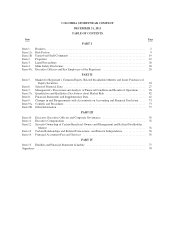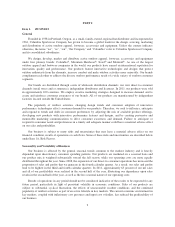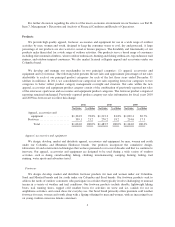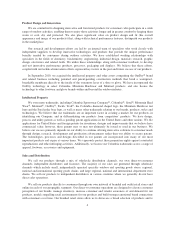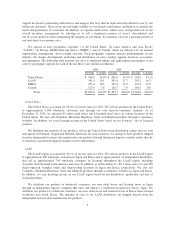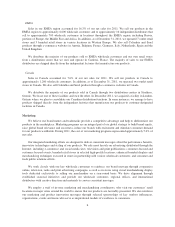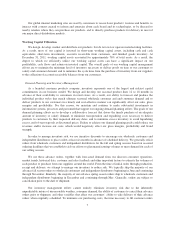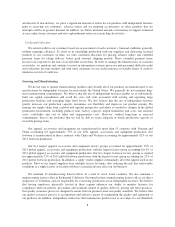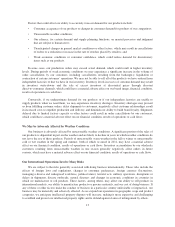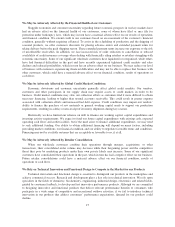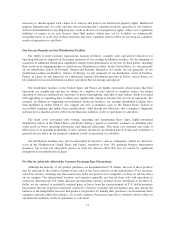Columbia Sportswear 2011 Annual Report Download - page 16
Download and view the complete annual report
Please find page 16 of the 2011 Columbia Sportswear annual report below. You can navigate through the pages in the report by either clicking on the pages listed below, or by using the keyword search tool below to find specific information within the annual report.We also have license agreements that permit unaffiliated parties to manufacture or contract to manufacture
products using our trademarks. We impose Standards of Manufacturing Practices on our independent factories
and licensees for the benefit of workers and require compliance with our restricted substances list and product
safety and other applicable environmental, health and safety laws. We also require our independent factories and
licensees to impose these practices, standards and laws on their contractors. However, if an independent
manufacturer or licensee violates labor or other laws, or engages in practices that are not generally accepted as
ethical in our key markets, we may be subject to production disruptions or significant negative publicity that
could result in long-term damage to our brands, and in some circumstances parties may attempt to assert that we
are liable for the independent manufacturer’s or licensee’s practices, which could have a material adverse effect
on our financial condition, results of operations or cash flows.
We May be Adversely Affected by Volatility in Global Production and Transportation Costs and Capacity
Our product costs are subject to substantial fluctuation based on:
• Availability and quality of raw materials;
• The prices of oil, cotton and other raw materials whose prices are determined by global commodity
markets and can be very volatile;
• Changes in labor markets and wage rates paid by our independent factory partners, which are often
mandated by governments in the countries where our products are manufactured, particularly in China
and Vietnam;
• Interest rates and currency exchange rates;
• Availability of skilled labor and production capacity at independent factories; and
• General economic conditions.
Prolonged periods of inflationary pressure on some or all input costs will result in increased costs to produce
our products that may result in reduced gross profit or necessitate price increases for our products that could
adversely affect consumer demand for our products.
In addition, since the majority of our products are manufactured outside of our principal sales markets, our
products must be transported by third parties over large geographical distances. Shortages in ocean freight
capacity, airfreight capacity and volatile fuel costs can result in rapidly changing transportation costs. For
example, during 2010, shortages of sourcing and transportation capacity, combined with later-than-optimal
production of advance orders, caused us to rely more heavily on airfreight to achieve timely delivery to our
customers, resulting in significantly higher freight costs. Because we price our products in advance and the
external cost changes may be difficult to predict, we may not be able to pass all or any portion of these higher
costs on to our customers or adjust our pricing structure in a timely manner in order to remain competitive, either
of which could have a material adverse effect on our financial condition, results of operations or cash flows.
We May be Adversely Affected by Volatile Economic Conditions
We are a consumer products company and are highly dependent on consumer discretionary spending
patterns and the purchasing patterns of our wholesale customers as they attempt to match their seasonal purchase
volumes to volatile consumer demand. In addition, as we have expanded our direct-to-consumer operations, we
have increased our exposure to the risks associated with volatile and unpredictable consumer discretionary
spending patterns. Consumer discretionary spending behavior is inherently unpredictable and consumer demand
for our products may not reach our sales targets, or may decline, especially during periods of heightened
economic uncertainty in our key markets, particularly markets in North America and the EMEA region. Our
sensitivity to economic cycles and any related fluctuation in consumer demand may have a material adverse
effect on our financial condition, results of operations or cash flows.
11


